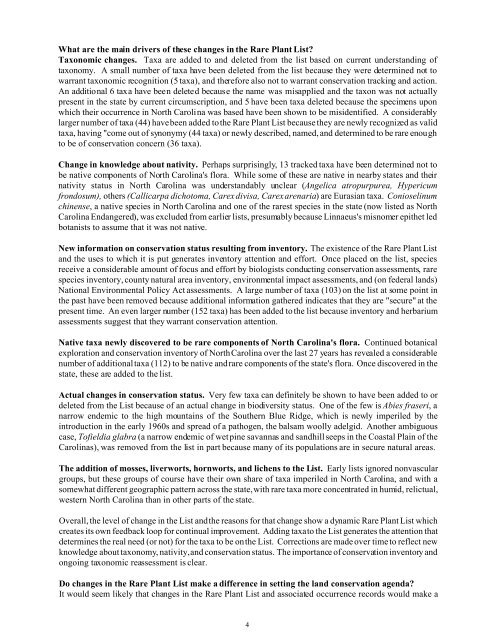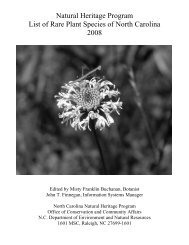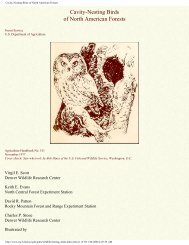Natural Heritage Program List of Rare Plant Species - Rawlings ...
Natural Heritage Program List of Rare Plant Species - Rawlings ...
Natural Heritage Program List of Rare Plant Species - Rawlings ...
Create successful ePaper yourself
Turn your PDF publications into a flip-book with our unique Google optimized e-Paper software.
What are the main drivers <strong>of</strong> these changes in the <strong>Rare</strong> <strong>Plant</strong> <strong>List</strong>?<br />
Taxonomic changes. Taxa are added to and deleted from the list based on current understanding <strong>of</strong><br />
taxonomy. A small number <strong>of</strong> taxa have been deleted from the list because they were determined not to<br />
warrant taxonomic recognition (5 taxa), and therefore also not to warrant conservation tracking and action.<br />
An additional 6 taxa have been deleted because the name was misapplied and the taxon was not actually<br />
present in the state by current circumscription, and 5 have been taxa deleted because the specimens upon<br />
which their occurrence in North Carolina was based have been shown to be misidentified. A considerably<br />
larger number <strong>of</strong> taxa (44) have been added to the <strong>Rare</strong> <strong>Plant</strong> <strong>List</strong> because they are newly recognized as valid<br />
taxa, having "come out <strong>of</strong> synonymy (44 taxa) or newly described, named, and determined to be rare enough<br />
to be <strong>of</strong> conservation concern (36 taxa).<br />
Change in knowledge about nativity. Perhaps surprisingly, 13 tracked taxa have been determined not to<br />
be native components <strong>of</strong> North Carolina's flora. While some <strong>of</strong> these are native in nearby states and their<br />
nativity status in North Carolina was understandably unclear (Angelica atropurpurea, Hypericum<br />
frondosum), others (Callicarpa dichotoma, Carex divisa, Carex arenaria) are Eurasian taxa. Conioselinum<br />
chinense, a native species in North Carolina and one <strong>of</strong> the rarest species in the state (now listed as North<br />
Carolina Endangered), was excluded from earlier lists, presumably because Linnaeus's misnomer epithet led<br />
botanists to assume that it was not native.<br />
New information on conservation status resulting from inventory. The existence <strong>of</strong> the <strong>Rare</strong> <strong>Plant</strong> <strong>List</strong><br />
and the uses to which it is put generates inventory attention and effort. Once placed on the list, species<br />
receive a considerable amount <strong>of</strong> focus and effort by biologists conducting conservation assessments, rare<br />
species inventory, county natural area inventory, environmental impact assessments, and (on federal lands)<br />
National Environmental Policy Act assessments. A large number <strong>of</strong> taxa (103) on the list at some point in<br />
the past have been removed because additional information gathered indicates that they are "secure" at the<br />
present time. An even larger number (152 taxa) has been added to the list because inventory and herbarium<br />
assessments suggest that they warrant conservation attention.<br />
Native taxa newly discovered to be rare components <strong>of</strong> North Carolina's flora. Continued botanical<br />
exploration and conservation inventory <strong>of</strong> North Carolina over the last 27 years has revealed a considerable<br />
number <strong>of</strong> additional taxa (112) to be native and rare components <strong>of</strong> the state's flora. Once discovered in the<br />
state, these are added to the list.<br />
Actual changes in conservation status. Very few taxa can definitely be shown to have been added to or<br />
deleted from the <strong>List</strong> because <strong>of</strong> an actual change in biodiversity status. One <strong>of</strong> the few is Abies fraseri, a<br />
narrow endemic to the high mountains <strong>of</strong> the Southern Blue Ridge, which is newly imperiled by the<br />
introduction in the early 1960s and spread <strong>of</strong> a pathogen, the balsam woolly adelgid. Another ambiguous<br />
case, T<strong>of</strong>ieldia glabra (a narrow endemic <strong>of</strong> wet pine savannas and sandhill seeps in the Coastal Plain <strong>of</strong> the<br />
Carolinas), was removed from the list in part because many <strong>of</strong> its populations are in secure natural areas.<br />
The addition <strong>of</strong> mosses, liverworts, hornworts, and lichens to the <strong>List</strong>. Early lists ignored nonvascular<br />
groups, but these groups <strong>of</strong> course have their own share <strong>of</strong> taxa imperiled in North Carolina, and with a<br />
somewhat different geographic pattern across the state, with rare taxa more concentrated in humid, relictual,<br />
western North Carolina than in other parts <strong>of</strong> the state.<br />
Overall, the level <strong>of</strong> change in the <strong>List</strong> and the reasons for that change show a dynamic <strong>Rare</strong> <strong>Plant</strong> <strong>List</strong> which<br />
creates its own feedback loop for continual improvement. Adding taxa to the <strong>List</strong> generates the attention that<br />
determines the real need (or not) for the taxa to be on the <strong>List</strong>. Corrections are made over time to reflect new<br />
knowledge about taxonomy, nativity, and conservation status. The importance <strong>of</strong> conservation inventory and<br />
ongoing taxonomic reassessment is clear.<br />
Do changes in the <strong>Rare</strong> <strong>Plant</strong> <strong>List</strong> make a difference in setting the land conservation agenda?<br />
It would seem likely that changes in the <strong>Rare</strong> <strong>Plant</strong> <strong>List</strong> and associated occurrence records would make a<br />
4




